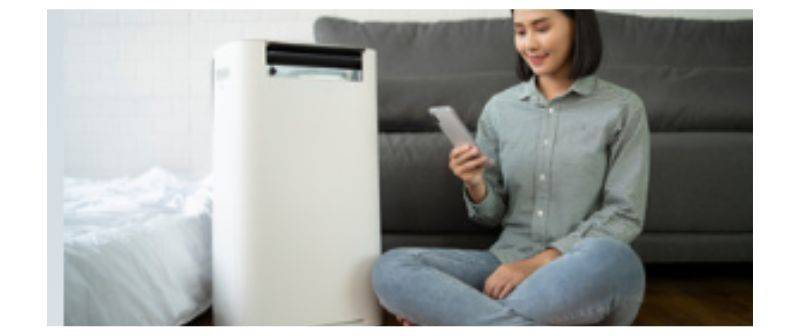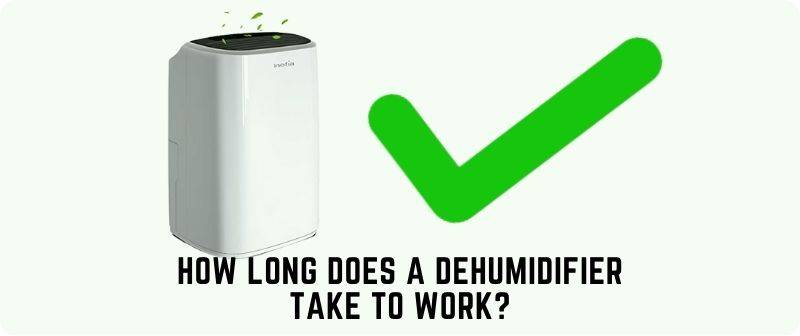Dehumidifiers work in a similar way to air conditioners in the sense that both create a cool atmosphere when they operate.
Dehumidifiers are able to eliminate moisture from your home without relying on cold air by forcing moisture through filters. When moisture passes through the filters, it causes condensation, thus removing moisture from your home.
A dehumidifier should begin collecting moisture from the space slowly before you start to see any significant changes in your living space.
The time it takes to do this depends on how big your home is and how humid it is. During the peak of summer, it may take up to ten hours.
Nevertheless, the longer it takes a dehumidifier to do its job, the longer you will have to endure the discomfort brought on by an oversaturated water level in your home when it is meant to do its job.
How Long Does A Dehumidifier Take To Work
If your home is humid and it’s taking too long for your dehumidifier to remove the moisture from it, then you might wonder if your dehumidifier is broken.
How to Know If Your Dehumidifier is Working

If you don’t know whether your dehumidifier is working or not, there are a few methods you can use to figure out if it is working.
- Check the hygrometer
A hygrometer can assist you in keeping track of variations in the humidity levels in your home while your dehumidifier is running. If your dehumidifier does not already have a built-in humidistat, think about buying one.
- Check the Humidistat
A humidistat is a feature that is included in the majority of dehumidifiers. If your dehumidifier contains a humidistat, you might use it to determine the humidity levels in your house at various times.
Immediately after turning on your dehumidifier, you should check the humidity levels in your home to see if they have changed. An hour or so later, revisit the humidistat readings to see if there have been any changes.
- Check also the water tank for any signs of condensation or water.
In the event that a dehumidifier is properly working, there is a variety of factors that will determine the length of time a dehumidifier will last:
This is how it works:
- Size of the unit:
If you want to know if a dehumidifier will effectively remove humidity from a space within 24 hours, you should look at the extraction capacity specs before you buy one.
The three sizes that are most frequently used are 25 pints, 50 pints, and 75 pints (Pint being the commonly used measurement for volume or capacity). The unit’s ability to extract more water in a given length of time increases with capacity.
Usually, your dehumidifier takes 5 to 6 hours to lower the humidity levels in your home if the proper conditions are provided.
Typically, larger and more powerful dehumidifiers have a much better chance of extracting more moisture from the air in a shorter amount of time than smaller models.
A dehumidifier that has a greater capacity will not require a full-power operation to cover the same surface area, thereby lowering the cost of operation.
Due to its capacity, you can begin to feel changes in the humidity levels in a space within the first five minutes of a large dehumidifier compared to when using a small dehumidifier.
- Size of the room
A dehumidifier that is placed in a smaller room will take a shorter period of time to dehumidify a room as compared to a dehumidifier that is placed in a larger room because a smaller room has a shorter area for the dehumidifier to work effectively.
- Humidity level:
The amount of moisture or humidity in your home will affect how long it takes for you to detect a significant change in the amount of humidity there.
A dehumidifier will take longer to bring the room’s humidity down to a comfortable level if it is very high. On the other hand, a dehumidifier will be more effective at removing excess moisture if the humidity level is already low.
You may need to run your dehumidifier for several hours throughout the day if the humidity is too high in order to significantly reduce the humidity in the air. The dehumidification process in your home may be slowed down by damp walls and floors.
Therefore, how can you make the most of your dehumidifier’s capabilities and not run your electricity bill up to the sky?
The timing of your dehumidifier is very important when using it. In order to maintain the right humidity level in your home, it is recommended that you use your dehumidifier for at least 12 hours every day.
To avoid running into high electric bills, it’s advisable to set humidity level targets. For a healthy, comfortable home, you should keep it between 40 and 55% humidity.
However, the amount of humidity will impact the dehumidifier’s runtime, whether you like a home with a humidity level closer to 40% or 55%. If your dehumidifier is configured to turn off when the humidity in your room exceeds 40% it will turn off at 40% and If it is programmed to turn off at 55% humidity, it will need to run longer.
Here is another article for information Why Is My Portable Humidifier Leaking From The Bottom
- Airflow:
In order to remove moisture from the air, a dehumidifier draws it in from the surrounding space. The dehumidifier will be able to function more effectively and swiftly eliminate moisture if there is excellent airflow in the room.
To ensure that it can efficiently carry out its functions, you should put your dehumidifier in an open area, ideally in the middle of the room. Also, placing the dehumidifier on higher surfaces, such as a table, is preferable to the floor to provide sufficient airflow.
- Use and maintenance:
When used and maintained correctly, dehumidifiers will function more effectively. This is why it’s so crucial to perform routine maintenance. For example, filters that are dirty increase the likelihood of a frozen coil and significantly reduce the amount of air passing over the evaporator.
A dehumidifier’s performance is greatly influenced by cleanliness, so make sure to change the filter annually. Spray some disinfectant and then use soap. To prevent accidents, always disconnect the equipment before cleaning it.
Condenser coils and exhaust grilles should be cleaned to remove dust. When cleaning these parts, use a vacuum cleaner with a small attachment.
If you decide to replace your dehumidifier in the meantime, talk about the parts that require replacement with the manufacturer beforehand.
- Regularly clean the water tank.
Clean the water tank with soap and a brush, just as you would the filter. Use a disinfectant to spray it. When the water tank is full or after you have finished using your dehumidifier, make sure to empty the water tank. Leaving the water in the tank could result in overflowing, which could lead to functional issues.
Close doors and windows near the dehumidifier.
Leaving your doors and windows open, particularly in warm weather when humidity levels are high, may raise the humidity levels in your home.
The dehumidifier could bring in some outside air if you leave your doors and windows open. Your dehumidifier’s performance could consequently suffer as a result. The walls and any nearby furniture may also block your dehumidifier if you keep it in a corner.
In a similar way, if it rains, some of the raindrops may find their way inside your house and raise the humidity levels inside.
Conclusion
Always be patient and give your dehumidifier time to do its job when operating it, in general. Most of the time, it takes a dehumidifier a few minutes to absorb enough moisture from the air to noticeably lower the humidity levels.
Make sure to monitor the humidity levels while your dehumidifier is running to make sure they don’t go far below the advised range.
You can phone the dehumidifier manufacturer’s customer service and request assistance if, after ten to twelve hours, your dehumidifier is still not functioning.
- 23 Must Try Outdoor Fire Pit Setups for Cozy Nights - July 5, 2025
- 24 Modern Fire Pit Ideas to Elevate Your Backyard Style - July 5, 2025
- 15 Unique DIY Fire Pit Ideas That Instantly Upgrade Your Backyard - July 4, 2025

